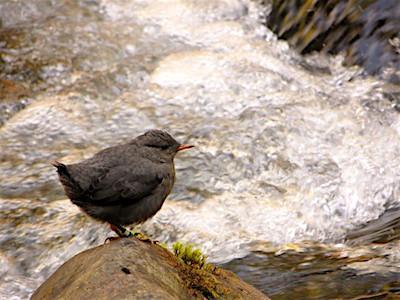
American Dippers are making a strong comeback in the wake of the rubble of the Elwha and Glines Canyon dams in and around Olympic National Park/Ohio State University
Editor's note: The following article comes largely from a release from Ohio State University.
It hasn't been too long since the Elwha and Glines Canyon dams were demolished, yet already the ecosystem in and around Olympic National Park in Washington state is rebounding in ways that are amazing some researchers.
Two new studies led by Christopher Tonra, assistant professor of avian wildlife ecology at Ohio State University, illustrate the stress dams impose on species that rely on salmon and the impact of dam removal on the well-being of that wildlife.
In one study, American Dippers, a songbird species that is uniquely equipped to forage its meals on the bottom of streams, is rebounding more quickly than was expected in the wake of the two dams' removal. Why? The birds flourish on the salmon-rich side of dams, yet struggle to get by on the opposite side cutoff from the fish and the nutrients they bring to the ecosystem.
“It’s exciting to be able to show a real positive outcome in conservation. We don’t always get that,” said Tonra in a release from Ohio State. “That these rivers can come back within our own generation is a really exciting thing.”
During his time conducting the studies in Washington, Tonra watched reservoir beds that looked like moonscapes return to vibrant, rich habitat and cascades emerge where none had been, at least for the last century.
“Watching that happen was just incredible,” he said.
Tonra and his colleagues studied the American Dipper, a bird species equipped with a transparent second eyelid that dives below the river’s surface and walks the riverbed scouring the rocky floor for meals, mostly aquatic insects in their larval stage. They also eat some small fish, including juvenile salmon when they’re available.
The studies are the first to examine the effects of dams, and dam removal, on the Dipper, considered an indicator species and the only bird of its type found in North America. Dippers that are faring well point to a strong ecosystem in and around the river.
“These birds are right where aquatic and terrestrial ecosystems meet,” Tonra said.
The scientist and his colleagues spent four years in the national park and on surrounding lands studying how the ecosystem is rebounding from the removal of the two dams, which started in 2011 and was completed in 2014. With the dams out of the way, salmon quickly returned to spawn. The fish carry marine-derived nitrogen and carbon back into freshwater systems when they return to spawn and die. They benefit animals and plants, whether through direct consumption or because nutrients find their way into plants and other food, including larval mayflies and other insects for which the dipper dives.

Christopher Tonra bands an American Dipper/Ohio State University
“They’re truly fertilizing the river and so that makes its way all the way up through the food chain,” Tonra said.
One beneficiary of the nutrient loading are Dippers. The studies showed that American Dippers with access to salmon were in better physical condition and more likely to attempt multiple broods of offspring in a season. They also produced larger female offspring and were more likely to stay in breeding territories year-round.
The team’s second Dipper study, published in this month's issue of the journal Biological Conservation, showed that within a year of the Elwha Dam removal an increase in salmon-derived nutrients appeared in American Dippers.



Comments
Why do dippers dip? Perhaps there are multiple reasons this has survival value. My long-held hypothesis is that they are using paralax to compensate for refraction in order to precisely locate food under water.